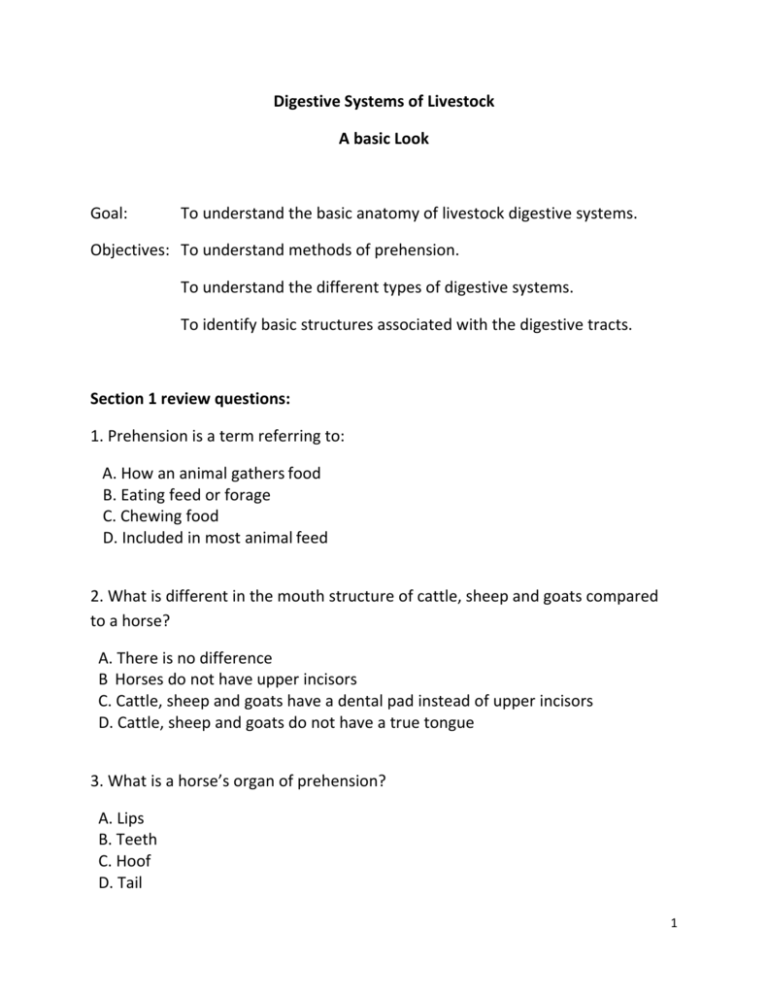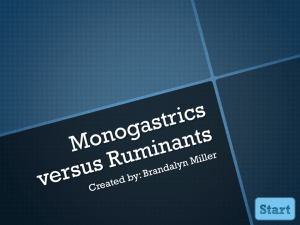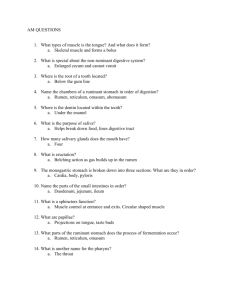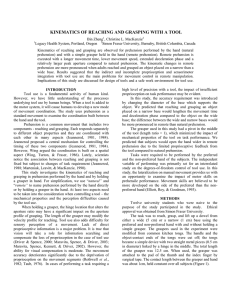Digestive Systems of Livestock: A Basic Look
advertisement

Digestive Systems of Livestock A basic Look Goal: To understand the basic anatomy of livestock digestive systems. Objectives: To understand methods of prehension. To understand the different types of digestive systems. To identify basic structures associated with the digestive tracts. Section 1 review questions: 1. Prehension is a term referring to: A. How an animal gathers food B. Eating feed or forage C. Chewing food D. Included in most animal feed 2. What is different in the mouth structure of cattle, sheep and goats compared to a horse? A. There is no difference B Horses do not have upper incisors C. Cattle, sheep and goats have a dental pad instead of upper incisors D. Cattle, sheep and goats do not have a true tongue 3. What is a horse’s organ of prehension? A. Lips B. Teeth C. Hoof D. Tail 1 4. What is a chicken’s organ of prehension? A. Tongue B. Beak C. Crop D. Claw 5. What is a human’s organ of prehension? A. Mouth B. Teeth C. Hand D. Eye Section 2 review questions: 1.What is colic? A. An enzyme that helps digest food B. A digestive disorder C. Medication given to ease abdominal pain D. An additive included in most animal feed 2. In horses, most digestive disturbances result from? A. Underfeeding B. Overfeeding grains C. Too much water D. Over chewing hay 3. What type of digestive systems do cattle, sheep and goats have? A. Single B. Prehension C. Monogastric D. Ruminant 2 4. Which of the following animals would have a reticular groove? A. Colt B. Calf C. Lamb D. A+C E. B+C 5. What are two important structures of the horse’s digestive system? A. Stomach B. Reticulum C. Proximal colon D. A+C E. B+C Section 3 review questions: 1. What is the cecum? A. A blind sack B. A site of microbial digestion C. A thin walled structure D. All of the above. 2. Which of the following terms refers to the rear of an animal? A. Anterior B. Posterior C. Dorsal D. Ventral 3 3. What is the chicken’s true stomach A. Gizzard B. Proventriculus C. Crop D. Cloaca 4. Anterior refers to what part of an animal’s body? A. Rear B. Belly C. Head D. Back 5 .How many ceca do chickens have? A. One B. Two C. Three D. Four Section 4 review questions: 1. The cecum is comparable to what human organ? A. Gallbladder B. Pancreas C. Liver D. Appendix 2. Hair balls are: A. Undesirable B. Found in rumens C. Comprised mostly of hair D. All of the above 4 3. What is the function of the esophagus in ruminants? A. B. C. D. Carry material down Carry material back up None of the above Both A+B 4. Materials leaving the reticulum would enter into what structure. A. B. C. D. Abomasum Omasum Small intestine Large intestine 5. What causes hair balls? A. B. C. D. Certain feeds No one knows Animals are born with them Animals licking themselves Final review questions: 1. Identify the following from a horse. A. Stomach B. Gallbladder C. Small intestine 2. Identify the following from a horse A. Dental pads B. Incisors C. Molars 5 3. Identify the following from a cow A. Rumen B. Esophagus C. Omasum 4. Identify the following from a cow A. Pancreas B. Gallbladder C. Reticular groove 5. Identify the following from a chicken A. Crop B. Gizzard C. Cloaca 6. Identify the following from a chicken A. Stomach B. Gizzard C. Drumstick 7. Identify the following from a chicken A. liver B. heart C. Gallbladder 8. Identify the following from a pig A. Foot B. Cecum C. Stomach 9. Identify the following from a pig A. Liver B. Pancreas C. Stomach 6 10. Identify the following from a pig A. Gall bladder B. Pancreas C. Large intestine 11. How many stomach compartments does a ruminant have? A. Three B. Two C. 0ne D. Four 12. What does mastication mean? A. Eating B. Chewing C. Breathing D. Smelling 13. The teeth of what animal continue to grow throughout its life? A. Horse B. Cow C. Pig D. Sheep 14. If a horse is overfed the excess food escapes into what organ? A. Small intestine B. Large intestine or proximal colon C. Stomach D. Gall Bladder 15. Monogastric animals: A. Have complex stomachs B. Are ruminants C. Have two stomachs D. Have simple stomachs 7 16. What is another term used for the proximal colon? A. Small intestine B. Large intestine C. Rumen D. Reticulum 17. What structure aids milk in passing directly from the mouth to the abomasum in pre‐ruminants? A. Reticular groove B. Omasum C. Rumen D. Reticulum 18. Bile is: A. An organ located in the lower GI tract B. An acid found in the stomach of ruminants C. A liver secretion that aids in the digestion of fat D. Found only in ruminants E. 19. Which component is the true stomach of a ruminant? A. Rumen B. Reticulum C. Omasum D. Abomasum 20. The gizzard is: A. A highly muscular organ B. Found in chickens C. Used to grind feed D. All of the above 8 9












